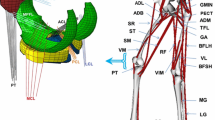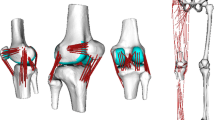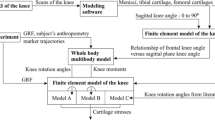Abstract
Information on knee loading and the relationship between muscle force and tissue response would benefit orthopaedic medicine, the development of engineered tissues, and our understanding of degenerative joint disease. As a step toward developing subject specific musculoskeletal simulations that predict loading on knee structures, this study combines a cadaver-based validated natural multibody knee model with a muscle driven forward dynamics simulation from a subject of similar height and weight for prediction of joint contact mechanics. Geometries for the multibody model were obtained from magnetic resonance images of a cadaver knee. The ligaments were represented with non-linear spring-damper elements with insertions and zero-load lengths derived from experimental measurements. The menisci were represented as discrete elements connected by 6×6 stiffness matrices and to allow prediction of contact pressure, the medial tibia plateau cartilage was divided into discrete elements. The force-displacement relationships of the knee model were validated by placing it in a model of a dynamic knee simulator and comparing predicted kinematics to experimental kinematics of the identically loaded cadaver knee. Motion, ground reaction forces, and surface electromyography were measured during a dual-limb squat on a female subject with similar height and weight as that of the cadaver donor. The gait data were used in a forward dynamics simulation of the dual-limb squat that included the cadaver knee model. The resulting tibio-femoral contact forces and pressures were compared for versions of the model with and without representation of the menisci. Inclusion of the menisci decreased the peak contact pressure on the medial tibia plateau by 20% and the cartilage-to-cartilage contact force on the lateral side was reduced by 40% through the squat cycle.











Similar content being viewed by others
References
Englund, M.: The role of biomechanics in the initiation and progression of OA of the knee. Best Pract. Res. 24(1), 39–46 (2010). doi:10.1016/j.berh.2009.08.008. S1521-6942(09)00085-0 [pii]
Heinlein, B., Kutzner, I., Graichen, F., Bender, A., Rohlmann, A., Halder, A.M., Beier, A., Bergmann, G.: ESB Clinical Biomechanics Award 2008: complete data of total knee replacement loading for level walking and stair climbing measured in vivo with a follow-up of 6-10 months. Clin. Biomech. 24(4), 315–326 (2009). doi:10.1016/j.clinbiomech.2009.01.011. S0268-0033(09)00024-2 [pii]
Gold, G.E., Besier, T.F., Draper, C.E., Asakawa, D.S., Delp, S.L., Beaupre, G.S.: Weight-bearing MRI of patellofemoral joint cartilage contact area. J. Magn. Reson. Imaging 20(3), 526–530 (2004). doi:10.1002/jmri.20146
Salsich, G.B., Ward, S.R., Terk, M.R., Powers, C.M.: In vivo assessment of patellofemoral joint contact area in individuals who are pain free. Clin. Orthop. Relat. Res. 417, 277–284 (2003). doi:10.1097/01.blo.0000093024.56370.79
Liu, F., Kozanek, M., Hosseini, A., Van de Velde, S.K., Gill, T.J., Rubash, H.E., Li, G.: In vivo tibiofemoral cartilage deformation during the stance phase of gait. J. Biomech. 43(4), 658–665 (2010). doi:10.1016/j.jbiomech.2009.10.028. S0021-9290(09)00602-2 [pii]
Anderst, W., Zauel, R., Bishop, J., Demps, E., Tashman, S.: Validation of three-dimensional model-based tibio-femoral tracking during running. Med. Eng. Phys. 31(1), 10–16 (2009). doi:10.1016/j.medengphy.2008.03.003. S1350-4533(08)00044-1 [pii]
Anderst, W.J., Tashman, S.: A method to estimate in vivo dynamic articular surface interaction. J. Biomech. 36(9), 1291–1299 (2003)
Papaioannou, G., Nianios, G., Mitrogiannis, C., Fyhrie, D., Tashman, S., Yang, K.H.: Patient-specific knee joint finite element model validation with high-accuracy kinematics from biplane dynamic Roentgen stereogrammetric analysis. J. Biomech. 41(12), 2633–2638 (2008). doi:10.1016/j.jbiomech.2008.06.027. S0021-9290(08)00317-5 [pii]
Zielinska, B., Donahue, T.L.: 3D finite element model of meniscectomy: changes in joint contact behavior. J. Biomech. Eng. 128(1), 115–123 (2006)
Pena, E., Calvo, B., Martinez, M.A., Doblare, M.: A three-dimensional finite element analysis of the combined behavior of ligaments and menisci in the healthy human knee joint. J. Biomech. (2005)
Perie, D., Hobatho, M.C.: In vivo determination of contact areas and pressure of the femorotibial joint using non-linear finite element analysis. Clin. Biomech. 13(6), 394–402 (1998). S0268003398000916 [pii]
Yao, J., Snibbe, J., Maloney, M., Lerner, A.L.: Stresses and strains in the medial meniscus of an ACL deficient knee under anterior loading: a finite element analysis with image-based experimental validation. J. Biomech. Eng. 128(1), 135–141 (2006)
Erdemir, A., McLean, S., Herzog, W., van den Bogert, A.J.: Model-based estimation of muscle forces exerted during movements. Clin. Biomech. 22(2), 131–154 (2007)
Blankevoort, L., Kuiper, J.H., Huiskes, R., Grootenboer, H.J.: Articular contact in a three-dimensional model of the knee. J. Biomech. 24(11), 1019–1031 (1991)
Pandy, M.G., Sasaki, K., Kim, S.: A three-dimensional musculoskeletal model of the human knee joint. Part 1: Theoretical construct. Comput. Methods Biomech. Biomed. Eng. 1(2), 87–108 (1998)
Bei, Y., Fregly, B.J.: Multibody dynamic simulation of knee contact mechanics. Med. Eng. Phys. 26(9), 777–789 (2004)
Caruntu, D.I., Hefzy, M.S.: 3-D anatomically based dynamic modeling of the human knee to include tibio-femoral and patello-femoral joints. J. Biomech. Eng. 126(1), 44–53 (2004)
Guess, T.M., Thiagarajan, G., Kia, M., Mishra, M.: A subject specific multibody model of the knee with menisci. Med. Eng. Phys. 32(5), 505–515 (2010). doi:10.1016/j.medengphy.2010.02.020. S1350-4533(10)00049-4 [pii]
Maletsky, L.P., Hillberry, B.M.: Simulating dynamic activities using a five-axis knee simulator. J. Biomech. Eng. 127(1), 123–133 (2005)
Guess, T.M., Maletsky, L.P.: Computational modeling of a dynamic knee simulator for reproduction of joint loading. In: 2003 ASME International Mechanical Engineering Congress & Exposition, Washington D.C. (2003)
Guess, T.M., Maletsky, L.P.: Computational modeling of a dynamic knee simulator for prediction of joint loading. In: Soslowsky, L.J. (ed.) ASME 2003 Summer Bioengineering Conference, Key Biscayne, Florida, pp. 859–860 (2003)
Thorp, L.E., Wimmer, M.A., Foucher, K.C., Sumner, D.R., Shakoor, N., Block, J.A.: The biomechanical effects of focused muscle training on medial knee loads in OA of the knee: a pilot, proof of concept study J. Musculoskelet. Neuronal Interact. 10(2), 166–173 (2010)
Guess, T.M., Liu, H., Bhashyam, S., Thiagarajan, G.: A multibody knee model with discrete cartilage prediction of tibio-femoral contact mechanics. Comput. Methods Biomech. Biomed. Eng., 1–15 (2011). doi:10.1080/10255842.2011.617004
Fithian, D.C., Kelly, M.A., Mow, V.C.: Material properties and structure-function relationships in the menisci. Clin. Orthop. 252, 19–31 (1990)
Donahue, T.L., Hull, M.L., Rashid, M.M., Jacobs, C.R.: A finite element model of the human knee joint for the study of tibio- femoral contact. J. Biomech. Eng. 124(3), 273–280 (2002)
Donahue, T.L., Hull, M.L., Rashid, M.M., Jacobs, C.R.: A finite element model of the human knee joint for the study of tibio-femoral contact. J. Biomech. Eng. 124(3), 273–280 (2002)
Hunt, K.H., Crossley, F.R.E.: Coefficient of restitution interpreted as damping in vibroimpact. J. Appl. Mech. 42(2), 440–445 (1975)
Duthon, V.B., Barea, C., Abrassart, S., Fasel, J.H., Fritschy, D., Menetrey, J.: Anatomy of the anterior cruciate ligament. Knee Surg. Sports Traumatol. Arthrosc. 14(3), 204–213 (2006)
Amis, A.A., Bull, A.M., Gupte, C.M., Hijazi, I., Race, A., Robinson, J.R.: Biomechanics of the PCL and related structures: posterolateral, posteromedial and meniscofemoral ligaments. Knee Surg. Sports Traumatol. Arthrosc. 11(5), 271–281 (2003). doi:10.1007/s00167-003-0410-7
Park, S.E., DeFrate, L.E., Suggs, J.F., Gill, T.J., Rubash, H.E., Li, G.: The change in length of the medial and lateral collateral ligaments during in vivo knee flexion. Knee 12(5), 377–382 (2005)
Wismans, J., Veldpaus, F., Janssen, J., Huson, A., Struben, P.: A three-dimensional mathematical model of the knee-joint. J. Biomech. 13(8), 677–685 (1980)
Al Nazer, R., Rantalainen, T., Heinonen, A., Sievanen, H., Mikkola, A.: Flexible multibody simulation approach in the analysis of tibial strain during walking. J. Biomech. 41(5), 1036–1043 (2008). doi:10.1016/j.jbiomech.2007.12.002. S0021-9290(07)00523-4 [pii]
Lifemodeler, I.: LifeMOD Manual (2010)
Acknowledgements
Development of the cadaver knee model was funded by the National Science Foundation, Grant Number 506297, under the IMAG program for Multiscale Modeling. The author gratefully acknowledges the work of Mohammad Kia and Gavin Paiva in the development of the macros used to generate the multibody tissue models for the menisci and cartilage. The author also acknowledges the contributions of researchers in the Experimental Joint Biomechanics Research Lab at the University of Kansas, Lawrence KS.
Author information
Authors and Affiliations
Corresponding author
Rights and permissions
About this article
Cite this article
Guess, T.M. Forward dynamics simulation using a natural knee with menisci in the multibody framework. Multibody Syst Dyn 28, 37–53 (2012). https://doi.org/10.1007/s11044-011-9293-4
Received:
Accepted:
Published:
Issue Date:
DOI: https://doi.org/10.1007/s11044-011-9293-4




